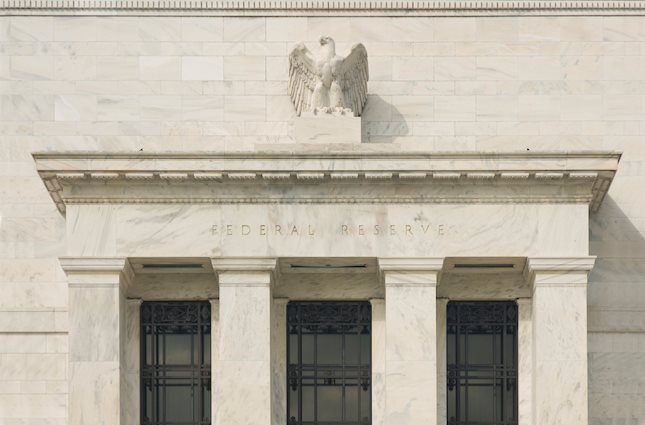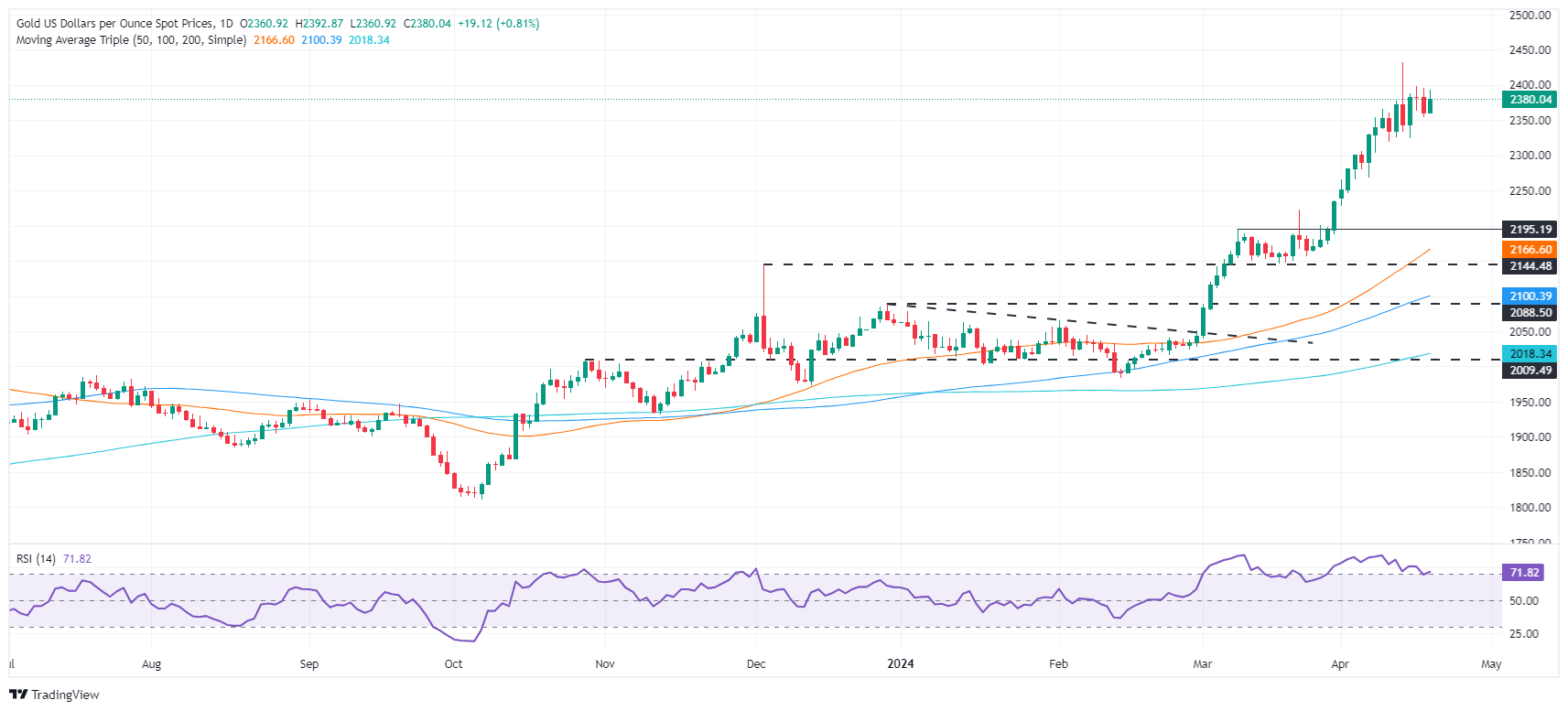- Gold remains lifted by geopolitical risks amid sharp rise in US Treasury yields.
- Federal Reserve officials emphasize ongoing inflation concerns, hinting at maintaining higher interest rates for longer.
- Strong US labor market data reinforces robust economic backdrop.
Gold prices advanced late in the North American session on Thursday, underpinned by heightened geopolitical risks involving Iran and Israel. Federal Reserve (Fed) officials delivered hawkish messages, triggering a jump in US Treasury yields, which boosted the Greenback.
XAU/USD trades at $2,384, with gains of more than 1%, after hitting a daily low of $2,361. Major central bank speakers are grabbing the spotlight, pushing aside the release of economic data from the United States (US), which paints an optimistic outlook for the labor market.
On Thursday, Fed policymakers crossed the wires. Atlanta Fed’s Raphael Bostic noted that inflation is too high, and the US central bank still has a way to go to tame it. He added the Fed won’t be able to reduce rates. Earlier, New York Fed President John Williams stated that the Fed is data-dependent and emphasized that monetary policy is in a good place, so he wasn’t in a rush to cut rates. His baseline doesn’t consider hiking rates but added that the Fed will hike if needed.
Following Bostic’s remarks and strong data that showed US Initial Jobless Claims remained unchanged compared to the previous reading, the golden metal continued to climb.
Daily digest market movers: Gold shrugs off higher yields, strong US data
- The US Department of Labor revealed that Initial Jobless Claims for the week ending April 13 fell to 212K, below the predicted 215K. Continuing Jobless Claims for the week of April 6 slightly rose to 1.812 million from 1.810 million but were still below the expected 1.818 million.
- The Philadelphia Fed Manufacturing Index increased significantly, jumping to 15.5, far surpassing minimal forecasts of 1.5. US Existing Home Sales declined by 4.3% MoM, falling from 4.38 million to 4.19 million, which was also below the anticipated 4.2 million.
- In the meantime, the CME FedWatch Tool shows the first rate cut could happen in September, with odds for a quarter percentage point cut standing at 66%, down from yesterday’s 71%.
- Despite decent US economic data, market participants seem to be focused on geopolitical risks.
- Tensions in the Middle East subsided after Israeli officials commented that they considered striking Iran on Monday but decided to wait, according to Axios. Jake Sullivan, the White House National Security Advisor, said the US decided to impose new sanctions on Iran in the upcoming days.
- US Dollar Index (DXY), which tracks the buck’s performance against a basket of six other currencies, loses 0.15% to 105.96.
- Gross Domestic Product (GDP) estimates for Q1 2024 show that the US economy is expected to grow 2.9%, up from 2.8% estimated on April 15, according to the Atlanta GDPNow model.
Technical analysis: Gold rises despite RSI in overbought levels
The Gold price remains bullishly biased, and price action of the last couple of trading days appears to form a Bullish Harami chart pattern that reassembles an inside day. That suggests the non-yielding metal could resume its uptrend, even though the Relative Strength Index (RSI) is at overbought levels. That said, buyers need to challenge the $2,400 figure. Once cleared, that could pave the way to test the year-to-date (YTD) high at $2,431.78, ahead of $2,500.
On the other hand, if XAU/USD is headed for a correction, the first support would be the $2,350 mark, followed by the April 15 daily low of $2,324. Once surpassed, Gold might test $2,300.
Gold FAQs
Gold has played a key role in human’s history as it has been widely used as a store of value and medium of exchange. Currently, apart from its shine and usage for jewelry, the precious metal is widely seen as a safe-haven asset, meaning that it is considered a good investment during turbulent times. Gold is also widely seen as a hedge against inflation and against depreciating currencies as it doesn’t rely on any specific issuer or government.
Central banks are the biggest Gold holders. In their aim to support their currencies in turbulent times, central banks tend to diversify their reserves and buy Gold to improve the perceived strength of the economy and the currency. High Gold reserves can be a source of trust for a country’s solvency. Central banks added 1,136 tonnes of Gold worth around $70 billion to their reserves in 2022, according to data from the World Gold Council. This is the highest yearly purchase since records began. Central banks from emerging economies such as China, India and Turkey are quickly increasing their Gold reserves.
Gold has an inverse correlation with the US Dollar and US Treasuries, which are both major reserve and safe-haven assets. When the Dollar depreciates, Gold tends to rise, enabling investors and central banks to diversify their assets in turbulent times. Gold is also inversely correlated with risk assets. A rally in the stock market tends to weaken Gold price, while sell-offs in riskier markets tend to favor the precious metal.
The price can move due to a wide range of factors. Geopolitical instability or fears of a deep recession can quickly make Gold price escalate due to its safe-haven status. As a yield-less asset, Gold tends to rise with lower interest rates, while higher cost of money usually weighs down on the yellow metal. Still, most moves depend on how the US Dollar (USD) behaves as the asset is priced in dollars (XAU/USD). A strong Dollar tends to keep the price of Gold controlled, whereas a weaker Dollar is likely to push Gold prices up.
Information on these pages contains forward-looking statements that involve risks and uncertainties. Markets and instruments profiled on this page are for informational purposes only and should not in any way come across as a recommendation to buy or sell in these assets. You should do your own thorough research before making any investment decisions. FXStreet does not in any way guarantee that this information is free from mistakes, errors, or material misstatements. It also does not guarantee that this information is of a timely nature. Investing in Open Markets involves a great deal of risk, including the loss of all or a portion of your investment, as well as emotional distress. All risks, losses and costs associated with investing, including total loss of principal, are your responsibility. The views and opinions expressed in this article are those of the authors and do not necessarily reflect the official policy or position of FXStreet nor its advertisers. The author will not be held responsible for information that is found at the end of links posted on this page.
If not otherwise explicitly mentioned in the body of the article, at the time of writing, the author has no position in any stock mentioned in this article and no business relationship with any company mentioned. The author has not received compensation for writing this article, other than from FXStreet.
FXStreet and the author do not provide personalized recommendations. The author makes no representations as to the accuracy, completeness, or suitability of this information. FXStreet and the author will not be liable for any errors, omissions or any losses, injuries or damages arising from this information and its display or use. Errors and omissions excepted.
The author and FXStreet are not registered investment advisors and nothing in this article is intended to be investment advice.
Recommended content
Editors’ Picks

AUD/USD trades modestly flat above 0.6430 after Aussie trade data
AUD/USD reacts little to better-than-expected Australian Goods Trade Balance data and remains in a range above 0.6400 early Thursday. Rising bets for an early RBA rate cut cap the Aussie's upside amid China's economic woes and US-Sino trade war fears. Eyes turn to US data, Fedspeak.

USD/JPY retreats further from the weekly top, slides below mid-150.00s
USD/JPY struggles to build on the previous day's strong move up to the weekly top and trades with a mild negative bias during the Asian session on Thursday. Bets for a December BoJ rate hike and the overnight sharp fall in the US bond yields lend some support to the lower-yielding JPY.

Gold price lacks firm near-term direction and is stuck in a familiar range
Gold price extends its sideways consolidative price move in a familiar range, awaiting a fresh catalyst before the next leg of a directional move. Geopolitical tensions, trade war fears and the overnight decline in the US bond yields offer support to the safe-haven XAU/USD.

Ripple's XRP could see a price rebound despite retail activity decline, RLUSD launch delay
XRP traded near $2.4 on Wednesday as Ripple Labs clarified that its RLUSD stablecoin will not debut on exchanges despite a rumored launch among crypto community members. Amid a sharp decline in XRP's price, on-chain data shows the remittance-based token still has the potential to resume its rally.

Four out of G10
In most cases, the G10 central bank stories for December are starting to converge on a single outcome. Here is the state of play: Fed: My interpretation of Waller’s speech this week is that his prior probability for a December cut was around 75% before the data.

Best Forex Brokers with Low Spreads
VERIFIED Low spreads are crucial for reducing trading costs. Explore top Forex brokers offering competitive spreads and high leverage. Compare options for EUR/USD, GBP/USD, USD/JPY, and Gold.
